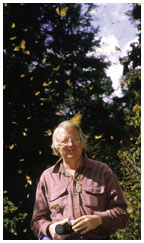|
Web Exclusives: Alumni Spotlight
June 6, 2004: Saving
monarchs Consumers have advocates, as do dusky salamanders, spotted owls, and retired racing greyhounds. Monarch butterflies have their advocate, too — biologist Lincoln Brower ’53, and it’s not because they are orange and black. (Though, Brower notes, “the juxtaposition of those two colors is as visually stimulating as you can get.”) Brower has been fascinated with butterflies for more than 60 years, since he lay in the “forest of weeds” outside his Morris County, New Jersey, home and observed the variety of life that exists at ankle level. Through the 1940s and the 1950s, he collected thousands of butterflies and moths, but many of the species he captured in New Jersey half a century ago are extinct or endangered today. Now he hopes that the monarch butterfly — whose extraordinary migratory life cycle he has studied for almost 50 years, starting at Princeton — won’t meet the same fate. Monarchs travel almost 3,200 miles during their lives, each fall leaving the chill of the northeastern U.S. and Canada for a temperate 1,800-square-mile mountain forest in central Mexico. There they spend the winter hanging from the lower boughs of fir trees, protected by thick canopies from all but the harshest weather. The monarchs cling to their boughs until late February or early March, then mate and take off for North America, where they lay eggs, hatch, mature, and wait for fall to begin the cycle again. The once-pristine forest in Mexico where monarchs spend their winters is shrinking. In the last 30 years, close to 45 percent of the forest has been lost to logging, says Brower, who majored in biology at Princeton and earned a Ph.D. in zoology at Yale in 1957. Now a research professor of biology at Virginia’s Sweet Briar College, after appointments at Amherst College and the University of Florida, Brower has visited the monarchs’ Mexican wintering grounds regularly since 1977 to conduct research and push conservation efforts. One day in January, he says, “I was hanging out of my seat at 13,000 feet in a Cessna aircraft flying with its door removed, so I could photograph two massive overwintering colonies in the Sierra Chincua and Sierra Campanario mountains in Michoacán.” The World Wildlife Federation has stepped up efforts to preserve the forest, and Mexican President Vicente Fox recently mandated increased protection of the monarchs’ winter habitat. But enforcing that mandate is problematic, says Brower. Logging provides income, and Brower realizes that conserving land for the butterflies strains the local economy. The best solution for humans and butterflies, Brower believes,
is ecotourism, an industry that is already successful in preserving
natural habitats in Costa Rica. Unfortunately, adopting ecotourism
as an economic base in the towns around the monarchs’ forest
is not immediately feasible, Brower says. The roads up into the
forest are treacherous, and food quality in the surrounding towns
is “dubious,” he says. But he hopes somebody “with
the dream and the finances” will spark a transformation to
ecotourism. That dream must be realized very soon, perhaps within
three or four years, Brower says, since there is “little chance
for ecotourism if the butterflies are gone.” By Marianne Eismann ’79 Marianne Eismann ’79 is an occasional contributor to PAW.
|
||

